Much like Ireland has been doing recently, Volterra has, over its millenia, been hitting above its weight, in terms relative to the size of its population. Here are some of the stories it has accumulated, which have add to Volterra’s cultural history and notoriety.
I have to admit that I haven’t read all of the criteria for being announced as being protected as a UNESCO Heritage site, but it just seems very odd to me that Volterra’s application has been waiting for so long.
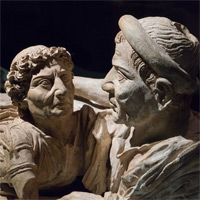 Volterra (Velathri, in the Etruscan language) was one of the twelve principal cities of the Etruscan League. It was a cultural cradle while Rome was still an upstart village on the banks of the Tiber. (I still have mad love for you, Rome!). In fact, it is Tuscany’s oldest continuously inhabited town.
Volterra (Velathri, in the Etruscan language) was one of the twelve principal cities of the Etruscan League. It was a cultural cradle while Rome was still an upstart village on the banks of the Tiber. (I still have mad love for you, Rome!). In fact, it is Tuscany’s oldest continuously inhabited town.
 It is one of the principal centres for production of alabaster works in Europe, if not the principal centre. It was for centuries, and then trade fell off. It picked back up again in the eighteenth century, from which time Volterra has ruled the roost! Check out alab’Arte, from where I pilfered this photo.
It is one of the principal centres for production of alabaster works in Europe, if not the principal centre. It was for centuries, and then trade fell off. It picked back up again in the eighteenth century, from which time Volterra has ruled the roost! Check out alab’Arte, from where I pilfered this photo.
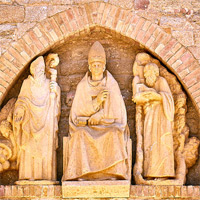 The second Pope, St. Linus, was born in Volterra. His cathederal is one of the few places we haven’t visited yet, as it was being renovated. It may have reopened by now, so hopefully we’ll take a look when we get over there.
The second Pope, St. Linus, was born in Volterra. His cathederal is one of the few places we haven’t visited yet, as it was being renovated. It may have reopened by now, so hopefully we’ll take a look when we get over there.
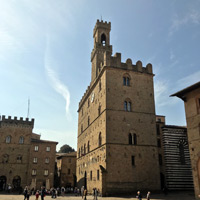 The main building of office in Volterra is still the 13th century Palazzo dei Priori, in the main square. It is the oldest town hall in Tuscany. So enamoured were the Medici by its design, that it was ‘culturally appropriated’, in that they based their Palazzo Vecchio in Florence on it. It’s still used for officialdom, but you can also visit a museum and the bell-tower there.
The main building of office in Volterra is still the 13th century Palazzo dei Priori, in the main square. It is the oldest town hall in Tuscany. So enamoured were the Medici by its design, that it was ‘culturally appropriated’, in that they based their Palazzo Vecchio in Florence on it. It’s still used for officialdom, but you can also visit a museum and the bell-tower there.
 If you were to stand beside the bell in the Palazzo dei Priori, you would be about 560 meters above sea-level, making Volterra Tuscany’s highest hilltown. I can see our house from here!
If you were to stand beside the bell in the Palazzo dei Priori, you would be about 560 meters above sea-level, making Volterra Tuscany’s highest hilltown. I can see our house from here!
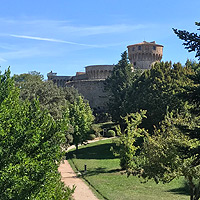 There is a Medicean fortress that dominates the south of the town. There are only three ways you can visit it, however: (1) go to dinner there; (2) visit someone housed there; or (3) be a very naughty boy and earn a prison sentence. Yes, it is, in fact, a medium-security prison. However, it is a very progressive one. Eight or so times a year, you can book yourself in to attend the so-called Cene Galeotte, where prisoners, aided by volunteering expert chefs help prepare food and provide waiting service, to help them get back on their feet by learning a trade. More improbably, one of Italy’s finest theatrical troupes is made up of inhabitants of the Fortezza.
There is a Medicean fortress that dominates the south of the town. There are only three ways you can visit it, however: (1) go to dinner there; (2) visit someone housed there; or (3) be a very naughty boy and earn a prison sentence. Yes, it is, in fact, a medium-security prison. However, it is a very progressive one. Eight or so times a year, you can book yourself in to attend the so-called Cene Galeotte, where prisoners, aided by volunteering expert chefs help prepare food and provide waiting service, to help them get back on their feet by learning a trade. More improbably, one of Italy’s finest theatrical troupes is made up of inhabitants of the Fortezza.
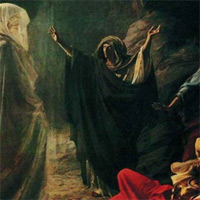 The progenitor of your typical medieval witches was also reputed for have been born in Volterra, supposedly on August the 13th, 1313. Her name was Aradia. Read more about her here. I haven’t yet visited the rock or caves, but that might change during my sabbatical.
The progenitor of your typical medieval witches was also reputed for have been born in Volterra, supposedly on August the 13th, 1313. Her name was Aradia. Read more about her here. I haven’t yet visited the rock or caves, but that might change during my sabbatical.
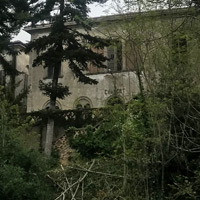 Volterra was home to a another town of sorts, on its outskirts. During its dismal apex, it housed as many people as the walled town itself did – about 6,000. It was a psychiatric hospital. It began life as an institution which genuinely sought to help the mentally infirm, but became something much more insidious. You can read more about it here and here.
Volterra was home to a another town of sorts, on its outskirts. During its dismal apex, it housed as many people as the walled town itself did – about 6,000. It was a psychiatric hospital. It began life as an institution which genuinely sought to help the mentally infirm, but became something much more insidious. You can read more about it here and here.
It still remains, for all intents and purposes, abandoned, but I have now heard you can buy a ticket to visit. Chalk something else up for our upcoming visit!
Another interesting story, is that patients helped dig up the trash heap that lay outside the town’s walls, and exposed the Roman Amphitheatre, which had lain there for centuries, forgotten. Those that volunteered got clean bills of health.
 One of the most famous and progressive scenes depicting the Deposition of Christ was painted by Rosso Fiorentino, and originally housed in the cathedral of Volterra. It is now in the town’s art museum (pinacoteca), along with many other amazing pre-Renaissance pieces. It features, unusually, a red-headed Judas (bottom right).
One of the most famous and progressive scenes depicting the Deposition of Christ was painted by Rosso Fiorentino, and originally housed in the cathedral of Volterra. It is now in the town’s art museum (pinacoteca), along with many other amazing pre-Renaissance pieces. It features, unusually, a red-headed Judas (bottom right).
 One of Volterra’s greatest treasures is on public display, and acts as one of the entrances to the walled town: the Porta all’Arco. Part of it dates back to centuries BC. During WWII, the German’s threatened to destroy the gate, to impede the approaching allies. The remaining townsfolk (many of whom where women and children by then) begged the Germans to give them time instead to stop it up with rocks. They were given 24 hours. Incredibly they did it in time (it’s a big gate, with added depth) by forming a human conveyor belt, and so the gate remains intact today.
One of Volterra’s greatest treasures is on public display, and acts as one of the entrances to the walled town: the Porta all’Arco. Part of it dates back to centuries BC. During WWII, the German’s threatened to destroy the gate, to impede the approaching allies. The remaining townsfolk (many of whom where women and children by then) begged the Germans to give them time instead to stop it up with rocks. They were given 24 hours. Incredibly they did it in time (it’s a big gate, with added depth) by forming a human conveyor belt, and so the gate remains intact today.
 Most recently, Volterra has seen movie and TV sets come and go, and been associated with modern young-adult urban fantasy. Some scenes from the live-action version of Full Metal Alchemist were shot here, as well as much of Season 3 of The Medicis (still awaiting broadcast in Ireland, I think). Most famously, Volterra has been associated with Stephanie Meyer’s Twilight Trilogy, with some of the second book being set here. Sadly, only a few scenes of the film where shot in Volterra, with the majority of the outdoor stuff shot instead in Montepulciano, 70 miles away.
Most recently, Volterra has seen movie and TV sets come and go, and been associated with modern young-adult urban fantasy. Some scenes from the live-action version of Full Metal Alchemist were shot here, as well as much of Season 3 of The Medicis (still awaiting broadcast in Ireland, I think). Most famously, Volterra has been associated with Stephanie Meyer’s Twilight Trilogy, with some of the second book being set here. Sadly, only a few scenes of the film where shot in Volterra, with the majority of the outdoor stuff shot instead in Montepulciano, 70 miles away.